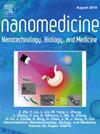顺序闪速纳米络合和闪速纳米沉淀使阿霉素负载纳米颗粒的可扩展组装。
IF 4.6
2区 医学
Q2 MEDICINE, RESEARCH & EXPERIMENTAL
Nanomedicine : nanotechnology, biology, and medicine
Pub Date : 2025-07-11
DOI:10.1016/j.nano.2025.102843
引用次数: 0
摘要
该研究提出了顺序闪速纳米络合(FNC)-闪速纳米沉淀(FNP)工艺,作为一种可扩展的方法,用于生产具有控制封装和释放阿霉素(DOX)的聚合物纳米颗粒(NPs)。在FNC步骤中,DOX首先与单宁酸(TA)交联,然后被人血清白蛋白(HSA)通过氢键稳定,形成均匀的DOX-TA-HSA纳米复合物。然后将纳米配合物包被聚乙二醇-聚乳酸-共羟基乙酸(PEG-b-PLGA),通过FNP溶解在各种水混溶的有机溶剂中。溶剂选择显著影响释放速度,二甲亚砜(DMSO)可以持续释放长达两周。此外,优化后的工艺具有出色的可重复性和可扩展性,批与批之间的变化最小。这种NP组装过程辅以切向流过滤(TFF)方法的可扩展净化,显示出保留的尺寸分布和DOX释放动力学。这项研究强调了FNC-FNP工艺在纳米治疗制造中的技术优势和转化潜力。本文章由计算机程序翻译,如有差异,请以英文原文为准。

Sequential flash nanocomplexation and flash nanoprecipitation enables scalable assembly of doxorubicin-loaded nanoparticles
The study presents the sequential flash nanocomplexation (FNC)–flash nanoprecipitation (FNP) process as a scalable method for producing polymeric nanoparticles (NPs) with controlled encapsulation and release of doxorubicin (DOX). In the FNC step, DOX is first crosslinked with tannic acid (TA), then stabilized by human serum albumin (HSA) via hydrogen bonding, forming uniform DOX-TA-HSA nanocomplexes. The nanocomplexes are then encapsulated into poly(ethylene glycol)-b-poly(lactic acid-co-glycolic acid) (PEG-b-PLGA) dissolved in various water-miscible organic solvents through FNP. Solvent selection significantly influenced the release rate, with dimethyl sulfoxide (DMSO) enabling sustained release for up to two weeks. Additionally, the optimized process demonstrated excellent reproducibility and scalability, with minimal batch-to-batch variations. This NP assembly process is complemented by scalable purification with the tangential flow filtration (TFF) method, showing preserved size distribution and DOX release kinetics. This study underscores the technical advantages and translational potential of the FNC–FNP process for nanotherapeutic manufacturing.
求助全文
通过发布文献求助,成功后即可免费获取论文全文。
去求助
来源期刊
CiteScore
11.10
自引率
0.00%
发文量
133
审稿时长
42 days
期刊介绍:
The mission of Nanomedicine: Nanotechnology, Biology, and Medicine (Nanomedicine: NBM) is to promote the emerging interdisciplinary field of nanomedicine.
Nanomedicine: NBM is an international, peer-reviewed journal presenting novel, significant, and interdisciplinary theoretical and experimental results related to nanoscience and nanotechnology in the life and health sciences. Content includes basic, translational, and clinical research addressing diagnosis, treatment, monitoring, prediction, and prevention of diseases.

 求助内容:
求助内容: 应助结果提醒方式:
应助结果提醒方式:


